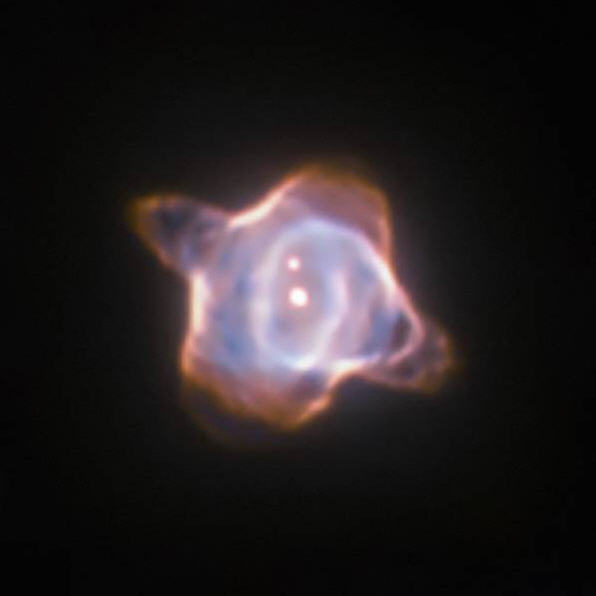Astronomers reveal secret of the rapid evolution of the central star in the Stingray Nebula

This image of the Stingray nebula, a planetary nebula 2700 light-years from Earth, was taken with the Wide Field and Planetary Camera 2 (WFPC2) of the Hubble Space Telescope in 1998. In the center of the nebula the fast evolving star SAO 244567 is located. Observations made within the last 45 years showed that the surface temperature of the star increased by almost 40 000 degree Celsius. Now new observations of the spectra of the star have revealed that SAO 244567 has started to cool again.
An international team of astronomers using the Hubble space telescope have been able to study stellar evolution in action. They observed dramatic increases in the temperature of the star SAO 244567 over several decades. Now the star is cooling again, having been reborn into an earlier phase of stellar evolution. This makes it the first reborn star to have been observed during both the heating and cooling stages of rebirth.
“SAO 244567 is one of the rare examples of a star that allows us to witness stellar evolution in real time,” explains Nicole Reindl from the University of Leicester, UK, lead author of the study. Reindl worked with a team of astronomers including Professor Klaus Werner and Dr. Thomas Rauch of University of Tübingen’s Institute of Astronomy and Astrophysics, where Reindl was formerly also based. Their results will be published in the upcoming Monthly Notices of the Royal Astronomical Society.
Even though the Universe is constantly changing, most processes are too slow to be observed within a human lifespan. Between 1971 and 1990 the surface temperature of the star rose dramatically. “Over only twenty years the star doubled its temperature and it was possible to watch it ionizing its previously ejected envelope, which is now known as the Stingray Nebula,” Reindl says.
Astronomers have been observing SAO 244567 for the past 45 years. While completing her doctoral thesis in Tübingen – her dissertation was awarded with the Doctoral Thesis Prize 2016 of the German Astronomical Society – Reindl analyzed all observations of the star and found that in 2002 it must have reached a maximum temperature of 60,000 Kelvin – 40,000 Kelvin more than thirty years earlier.
This is unusual, though not unheard-of, and the rapid heating could easily be explained if one assumed that SAO 244567 had an initial mass of 3 to 4 times the mass of the Sun. However, the data show that SAO 244567 must have had an original mass similar to that of our Sun. Such low-mass stars usually evolve on much longer timescales, so the rapid heating has been a mystery for decades.
Back in 2014 Reindl and her team proposed a theory that resolved the issue of both SAO 244567’s rapid increase in temperature as well as the low mass of the star. They suggested that the heating was due to what is known as a helium-shell flash event: a brief ignition of helium outside the stellar core.
This theory has very clear implications for SAO 244567’s future: if it has indeed experienced such a flash, then this would force the central star to begin to expand and cool again — it would return back to the previous phase of its evolution. This is exactly what the new observations confirmed. As Reindl explains: “The release of nuclear energy by the flash forces the already very compact star to expand back to giant dimensions — the born-again scenario.”
Yet no current stellar evolutionary models can fully explain SAO 244567’s behavior. As Reindl elaborates: “We need refined calculations to explain some still mysterious details in the behavior of SAO 244567. These could not only help us to better understand the star itself but could also provide a deeper insight in the evolution of central stars of planetary nebulae.” Until astronomers develop more refined models for the life cycles of stars, aspects of SAO 244567’s evolution will remain a mystery.
Publication:
Nicole Reindl, T. Rauch, M. M. Miller Bertolami, H. Todt, K. Werner: Breaking news from the HST: The central star of the Stingray Nebula is now returning towards the AGB. Monthly Notices of the Royal Astronomical Society (in press).
Contact:
Dr. Nicole Reindl
Formerly of the University of Tübingen
University of Leicester
Department of Physics and Anstronomy
Phone +44 (0)116 223 1385
E-mail nr152[at]le.ac.uk
Media Contact
More Information:
http://www.uni-tuebingen.de/All latest news from the category: Physics and Astronomy
This area deals with the fundamental laws and building blocks of nature and how they interact, the properties and the behavior of matter, and research into space and time and their structures.
innovations-report provides in-depth reports and articles on subjects such as astrophysics, laser technologies, nuclear, quantum, particle and solid-state physics, nanotechnologies, planetary research and findings (Mars, Venus) and developments related to the Hubble Telescope.
Newest articles

Hyperspectral imaging lidar system achieves remote plastic identification
New technology could remotely identify various types of plastics, offering a valuable tool for future monitoring and analysis of oceanic plastic pollution. Researchers have developed a new hyperspectral Raman imaging…

SwRI awarded $26 million to develop NOAA magnetometers
SW-MAG data will help NOAA predict, mitigate the effects of space weather. NASA and the National Oceanic and Atmospheric Administration (NOAA) recently awarded Southwest Research Institute a $26 million contract…

Protein that helps cancer cells dodge CAR T cell therapy
Discovery could lead to new treatments for blood cancer patients currently facing limited options. Scientists at City of Hope®, one of the largest and most advanced cancer research and treatment…



